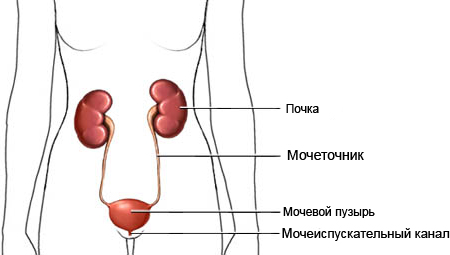Acute cystitis – Cystitis
Description of acute cystitis
Cystitis is a bladder infection. The bladder is part of the urinary tract, which remove the urine from the kidneys and collect it.

Causes of acute cystitis
Urinary path typically contain no microorganisms. But, sometimes bacteria or yeast from the lower gastrointestinal tract or rectal area enter the urinary tract, usually, through the urethra (tube, through which urine passes from the bladder). When bacteria or yeast fall into the urethra, they can multiply and infect the urethra. They then can infect the bladder.
In the majority of cases of cystitis are caused by bacteria from the rectal area. In women, the rectum and urethra are fairly close to each other. This allows the bacteria are relatively easy to get into the urethra. Some women develop cystitis after frequent intercourse, because bacteria enter the urethra during sex can cause infection.
Risk factors for acute cystitis
Factors, which increase the likelihood of acute cystitis:
- Paul: female;
- Sexual activity;
- Using a diaphragm for birth control;
- Using a condom – may increase the risk of infection in women, especially when used condom coated with nonoxynol-9;
- Menopause;
- Abnormalities of the urinary system, including vesicoureteral reflux or multicystic kidney disease;
- Paraplegia and other neurologic diseases;
- Drepanocytemia;
- Kidney transplantation;
- Diabetes Type 1 and type 2;
- Stones in the kidneys;
- Enlarged prostate (males);
- Weak immune system;
- Bladder catheter;
- Tight underwear and clothing;
- Chemicals in soaps, douches and lubricants.
Symptoms of acute cystitis
The symptoms of cystitis vary from mild to severe. These include:
- Frequent and urgent need to urinate;
- Selecting only a small amount of urine;
- Pain in the abdomen or pelvic region, lower back;
- Burning sensation while urinating;
- Leakage of urine;
- Increased need to get up at night, to urinate;
- Turbid, bad-smelling urine;
- Blood in the urine;
- Low-grade fever;
- Fatigue.
Diagnosis of acute cystitis
The doctor will ask about your symptoms and medical history, and perform a physical examination. Besides, a urine sample will be examined for blood, pus and bacteria. If urine contains bacteria, probably, It will be diagnosed with cystitis.
Sometimes cystitis may require additional testing. The doctor uses a cystoscope to check for structural abnormalities of the urinary system, that predispose them to infection.
Treatment of acute cystitis
Bacterial cystitis is treated with antibiotics. Antibiotics (usually, trimethoprim / sulfamethoxazole, nitrofurantoin, or a fluoroquinolone) appointed for at least 2-3 day and, perhaps, to several weeks. The duration of treatment depends on the severity of the infection and medical history. Improvement occurs a day or two. Nonetheless, must pass the entire course of treatment. Otherwise, the infection may reappear. After completion of the antibiotics need to perform repeated analysis of urine, To make sure, infections that do not really have.
If you have recurrent infections, your doctor may prescribe stronger antibiotics or taking them for a long period of time. It may also recommend low-dose antibiotics as a preventive or daily, or after intercourse. If recurrent infections persist, you may be referred to a specialist.
Phenazopyridine – medicine, which reduces pain and spasms of the bladder. When receiving phenazopyridine urine and sweat can sometimes buy the orange color. This medication, usually, available without a prescription and effectively relieves symptoms to health care.
Prevention of acute cystitis
You can take some steps, to prevent the ingress of bacteria in the urinary tract:
- Drink plenty of fluids;
- Include cranberry juice diet. Some studies show, that the use of cranberry juice to prevent urinary tract infections;
- We need to urinate, when you have the desire, and do not resist it;
- After intercourse, it is desirable to empty the bladder, and then drink a full glass of water;
- Daily MY genitals;
- If you are a woman, Always wipe the anus from front to back after a bowel movement;
- Avoid using syringes and feminine hygiene products in the form of a spray;
- Avoid tight underwear or clothing.
